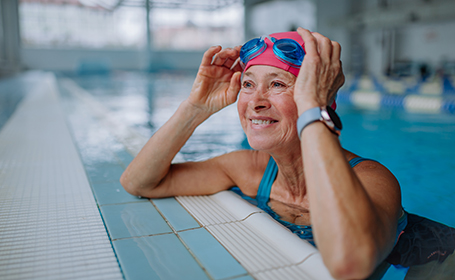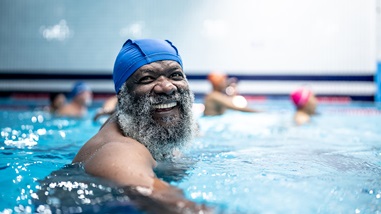
How swimming can help to strengthen your knees
If you're suffering from knee pain or injury, have you considered taking up swimming? This low-impact exercise builds up muscles around your knees and could help to ease your symptoms and have you feeling better all round.
Arthritis is another common cause, with approximately 1 in 5 UK adults suffering from osteoarthritis of the knee. Osteoarthritis is when the smooth cartilage across the surface of your knee joint wears down over time. You'll sometimes hear it referred to as wear and tear arthritis, and it's more common the older we get. The wear and tear can make your joint very painful and stiff and can really reduce your mobility.
This is the most common type of arthritis both in the UK and worldwide. Another common type of arthritis is rheumatoid arthritis. Rheumatoid arthritis (RA) currently affects more than 400,000 people in the UK. It is an inflammatory joint condition caused by an autoimmune process, which happens when your body attacks its healthy cells by mistake. This often causes pain, swelling, and inflammation in your joints. Joints affected by RA are commonly surrounded by inflamed tissue, which often results in chronic pain.
Although you might be tempted to stay away from exercise if you have a bad knee, it can often be one of the best ways to help it. Swimming, a low-impact activity that’s both accessible, enjoyable, and affordable, is a great place to start.
Find out more about swimming to aid recovery from a knee injury
Is it safe to exercise if I have knee pain?
Firstly, if you have recurring or constant knee pain or swelling, especially if it’s stopping you from going about your daily life, you should speak to your doctor. They’ll be able to diagnose you and also give advice on if and when you should start exercising. You might need treatment with a physiotherapist before you begin exercising properly. This is especially so if you've suffered a traumatic injury to your knee, or are recovering from surgery to your knee. According to the NHS, exercise should not make your existing knee pain worse overall. However, practicing new exercises can sometimes cause short term muscle pain as the body gets used to moving in new ways. This kind of pain should ease quickly and your pain should be no worse the morning after you've exercised.
Physiotherapy for joint pain comprises a specialist exercise programme designed to strengthen the muscles around your joints, improving mobility and – in taking the pressure of your joints – reducing your pain. It can be a highly effective treatment and many people see amazing results.
If your doctor has recommended exercise to rehabilitate and/or strengthen your knees, then it’s probably one of the best things you can do to feel better.
Swimming is a low-impact exercise that is commonly recommended for arthritis and other knee conditions. Your physiotherapist might recommend it as part of your recovery programme. They can offer specialist exercises you can perform in the water to strengthen the muscle around your knee.
Why swimming is good for knee pain
When you swim, the buoyancy of the water supports your body weight, meaning less stress is placed on your joints, which can reduce the pain you feel.
At the same time, water provides more resistance than air, so as you move through the water your muscles are working harder than they feel like they are. Many people find swimming is a good way to exercise vigorously without hurting themselves or feeling muscle tension from exercise.
If you swim in warm water, you might also find that the temperature soothes your joints and eases your pain.
Watch our video for more tips on managing joint pain
If you swim regularly, the muscles around your knees will build up, strengthening the support around your joint. This can not only relieve pain but also reduce the chance of pain in the future.
Swimming is also a great cardiovascular exercise, meaning it can help you to stay fit, burn calories and lose weight. Losing weight is one of the best things you can do to reduce knee pain. One study found that for every pound of weight lost, four pounds of pressure were taken off the knee joint.
Swimming has benefits for your mental wellbeing, too. It can boost your mood and reduce your stress levels. It has also been shown to help people sleep better. Swimming helps reduce endorphins and improve anxiety and depression.
Other health benefits of swimming
Swimming is good for strengthening more than just your knees. It offers a whole-body workout, improving your fitness and muscle strength from head to toe. It can also improve your mobility, flexibility and endurance, as well as strengthen your core.
Regular swimming has been shown to reduce the risk of many illnesses, including heart disease, type 2 diabetes and stroke. There is evidence that swimmers live longer and stay fit for longer, and in children it has been shown to encourage development. In an article about the many benefits of swimming, The British Heart Foundation reports that it’s easy to underestimate how hard your body is working when you swim (because of the buoyancy and the fact that you don’t feel hot and sweaty).
Swimming has benefits for your mental wellbeing, too. It can boost your mood and reduce your stress levels. It has also been shown to help people sleep better. Swimming helps reduce endorphins and improve anxiety and depression.

Other water-based exercises you could try
Swimming is great for you, but it’s not the only way to take advantage of the water to improve your health and strengthen your knees.
Hydrotherapy
Hydrotherapy is physiotherapy that you do in a warm-water pool. The water supports you and the temperature can help your muscles relax. The effects of the water and warm temperature can help to reduce pain and provide support your recovery and improve flexibility and strength in your knee. It works by gently warming your muscles to help them relax and ease any pain in your joints.
You will be asked to perform a range of specially tailored movements in the pool both with and against the water. These will help to strengthen your muscles while the water surrounds you to support your body.
Hydrotherapy is different to aqua-aerobics, which is a higher-intensity form of exercise. Instead, it is generally more focused on slow, controlled movements and relaxation.
If you are living with knee pain that's affecting your quality of life or want support during your rehabilitation after surgery, hydrotherapy could be a great option to help you feel better. Get in touch today to arrange a session with a physiotherapist to find out if hydrotherapy could help you.
Water walking
Water walking is like regular walking, but you do it in a swimming pool. As with swimming, the water takes some of the strain off your knees, minimising your pain. Many people also find the temperature soothes their joints.
Because water provides more resistance than air, walking in water requires more effort, so it will burn more calories than a regular walk.
Water aerobics (also called aquatics or aquatic exercise) is popular among people with arthritis because classes offer an effective but low-impact workout.
Water aerobics
Water aerobics (also called aquatics or aquatic exercise) is popular among people with arthritis because classes offer an effective but low-impact workout. Many classes are set up specifically to help people with the condition.
As with water walking, water offers increased resistance but takes the pressure of your knees.
How to get started
Before starting any new exercise regime, speak to your GP or consultant. They can help to give advice on the best course of action for your individual needs.
If you haven’t been in the habit of exercising, it’s important to start slow. Begin with gentle sessions and work up to longer and more frequent swims.
If you’re not a confident swimmer, look into lessons. A swimming instructor or physiotherapist can help you hone your technique and show you the best approach to strengthen your knees without hurting yourself.
At Circle Health Group, you can book an appointment with one of our physiotherapists to begin your tailored programme for knee pain.
Tags
How do I book an appointment?
If you're concerned about symptoms you're experiencing or require further information on this subject, talk to a GP or see an expert consultant at your local Circle Hospital.